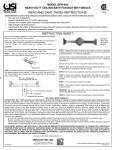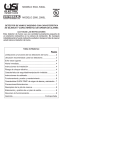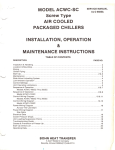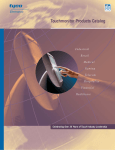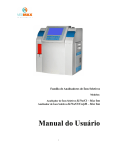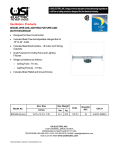Download Universal Security Instruments USI-1227L User's Manual
Transcript
Visit Us on the Web! www.UsiElectric.com
MODEL USI-1227L/USI-1228L
SMOKE & FIRE ALARM
SMOKE ALARM LIMITATIONS AND FUNCTIONS
There are three basic smoke alarm types: IoPhic ®, Ionization and Photoelectric.
IoPhic ® is an ionization alarm containing a patent-pending Universal Smoke Sensing Technology. IoPhic
alarms® are very effective at detecting fast flaming fires and also respond very quickly to slow smoldering
fires - up to 87% faster than the maximum allowable alarm limit (UL217 Smoldering Smoke Test on 5/26/2010,
Underwriters Laboratories Project #09CA38078).
Ionization smoke alarms are typically more effective at detecting fast flaming fires - fires which consume combustible
materials rapidly and spread quickly. Sources of these fires may include paper burning in a wastebasket, or kitchen
grease fires.
Photoelectric smoke alarms, on the other hand, are typically more effective at detecting slow smoldering fires - fires
which burn for hours before bursting into flame. Sources of these fires may include cigarettes burning in couches
or bedding.
Installing IoPhic ® smoke alarms ensures maximum detection of both types of fires from a single alarm, while
eliminating the need for a combination of ionization and photoelectric smoke alarms.
The enclosed alarm is an Ionization smoke alarm.
SMOKE ALARMS WILL NOT WORK DURING A LOSS OF POWER. SINCE A SMOKE ALARM WILL NOT WORK
WITHOUT POWER, having an alarm(s) that works from two completely different power sources, such as an AC direct
wire with battery backup smoke alarm, can give you an extra measure of protection in case of an AC power failure or
a dead battery. Battery operated alarms cannot work if the batteries are missing, disconnected or dead, if the wrong
type of batteries are used or if the batteries are not installed correctly. AC (only) powered alarms cannot work if the
AC power is cut off for any reason. If you are concerned about the limitations of the battery or AC power, install both
types of alarms.
USING AN IONIZATION SMOKE ALARM IN A SMOKY AREA, SUCH AS A KITCHEN, OR IN A HIGH HUMIDITY
AREA NEAR A SHOWER, CAN CAUSE NUISANCE FALSE ALARMS. IT IS PREFERABLE TO USE
PHOTOELECTRIC ALARMS IN THESE AREAS. DO NOT TURN OFF THE AC POWER TO QUIET THE
ALARM. A SMOKE ALARM WILL NOT HELP PROTECT YOU IF IT IS NOT POWERED. Properly locate your
alarm to avoid nuisance alarms.
A SMOKE ALARM MAY NOTALWAYS WARN YOU ABOUT FIRES CAUSED BY CARELESSNESS AND SAFETY
HAZARDS LIKE SMOKING IN BED, VIOLENT EXPLOSIONS, ESCAPING GAS, IMPROPER STORAGE OF
FLAMMABLE MATERIALS, OVERLOADED ELECTRICAL CIRCUITS, CHILDREN PLAYING WITH MATCHES,
NATURAL CAUSES SUCH AS LIGHTNING, OR ARSON. FIRE PREVENTION IS YOUR BEST SAFEGUARD.
INSTALLING SMOKE ALARMS MAY MAKE YOU ELIGIBLE FOR LOWER INSURANCE RATES, BUT SMOKE
ALARMS ARE NOT A SUBSTITUTE FOR INSURANCE. Homeowners and renters alike should continue to insure
their lives and properties.
SMOKE ALARMS CANNOT DETECT FIRES IF THE SMOKE DOES NOT REACH THEM. Smoke from fires
may not reach the sensing chamber and set off the alarm. One alarm should be installed inside each bedroom or
sleeping area. Do not obstruct airflow around the smoke alarm or place in areas of obstructed airflow.
BE AWARE OF VARIOUS SITUATIONS AGAINST WHICH THE SMOKE ALARM MAY NOT BE EFFECTIVE. For
example: (1) Fires where the victim is intimate with a flaming initiated fire; for example, when a person's clothes catch
fire while cooking; (2) Fires where the smoke is prevented from reaching the alarm due to a closed door or other
obstruction or (3) Incendiary fires where the fire grows so rapidly that an occupant's egress is blocked even with
properly located alarms.
SMOKE ALARMS MAY NOT DETECT FIRE ON ANOTHER FLOOR OR AREA OF THE HOME. Recommended
minimum protection is at least one smoke alarm in every sleeping area and every bedroom on every level of your home.
Interconnected smoke alarms may provide earlier warning than stand-alone smoke alarms since all smoke alarms
alarm when one detects smoke.
SMOKE ALARMS MAY NOT BE HEARD. The alarm horn in this alarm meets or exceeds current standards, but
it may not be heard if: (1) the smoke alarm is located outside a closed or partially closed door; (2) residents recently
consumed alcohol or drugs; (3) the alarm is drowned out by noise from stereos, TV's, air conditioners or other
appliances; (4) residents are hearing impaired or (5) if residents are sleeping.
CURRENT STUDIES HAVE SHOWN SMOKE ALARMS MAY NOT AWAKEN ALL SLEEPING INDIVIDUALS
AND THAT IT IS THE RESPONSIBILITY OF INDIVIDUALS IN THE HOUSEHOLD WHO ARE CAPABLE OF
ASSISTING OTHERS TO PROVIDE ASSISTANCE TO THOSE WHO MAY NOT BE AWAKENED BY THE
ALARM SOUND OR TO THOSE WHO MAY BE INCAPABLE OF SAFELY EVACUATING THE AREA
UNASSISTED.
SMOKE ALARMS ARE NOT FOOLPROOF. You must test the smoke alarm weekly to ensure your continued
protection. Smoke alarms cannot prevent or extinguish fires.
SMOKE ALARMS HAVE A LIMITED LIFE. The smoke alarm should be replaced immediately if it is not operating
properly. You should always replace a smoke alarm after 10 years.
SMOKE ALARMS ARE NOT TO BE USED WITH DETECTOR GUARDS UNLESS THE COMBINATION HAS
BEEN EVALUATED AND FOUND SUITABLE FOR THAT PURPOSE.
RECOMMENDED LOCATION OF ALARMS
• Locate the first smoke alarm in the immediate area of the bedrooms. Try to protect the escape
route as the bedrooms are usually farthest from an exit. If more than one sleeping area exists,
locate additional smoke alarms in each sleeping area. If a hall is more than 40 feet (12 meters)
long, install a smoke alarm at each end.
• Locate additional smoke alarms to protect any stairway as stairways act like chimneys for
smoke and heat.
• Locate at least one smoke alarm on every floor level.
• Locate a smoke alarm in any area where a smoker sleeps or where electrical appliances are
operated in sleeping areas.
• Smoke, heat and other combustion products rise to the ceiling and spread horizontally. Mounting
the smoke alarm on the ceiling in the center of the room places it closest to all points in the room.
Ceiling mounting is preferred in ordinary residential construction. However, in mobile homes, wall
mounting on an inside partition is preferred to avoid the thermal barrier that may form at the
ceiling.
• When mounting smoke alarm on the ceiling, locate it a minimum of 4" (10cm) from a side wall
or corner (see Diagram A).
• When mounting smoke alarm on a wall, if local codes allow, use an inside wall with the top edge
of the smoke alarm a minimum of 4" (10cm) and a maximum of 12" (30.5cm) below the ceiling/
wall intersections (See Diagram A).
Existing Homes:
The NFPA requires a smoke alarm on every level and outside each sleeping area in existing construction. An
existing household with one level and one sleeping area is required to have one smoke alarm.
New Construction Homes and Manufactured Homes:
The NFPA requires AC-powered, interconnected smoke alarms to be installed inside each bedroom, outside each
bedroom area, and on every level of the home. They also require a minimum of two AC-powered, interconnected
smoke alarms in any new construction home.
Sloped Ceilings (Peaked Ceilings):
Smoke alarms or smoke detectors mounted on a peaked ceiling shall be located within 36 in. (914 mm) horizontally
of the peak, but not closer than 4 in. (102 mm) vertically to the peak.
Sloped Ceilings (Shed Ceilings):
Smoke alarms or smoke detectors mounted on a sloped ceiling having a rise greater than 1 ft. in 8 ft. (1 m in 8
m) horizontally shall be located within 36 in. (914 mm) of the high side of the ceiling, but not closer than 4 in. (102
mm) from the adjoining wall surface.
Tray-Shaped Ceilings:
Smoke Alarms or smoke detectors shall be installed on the highest portion of the ceiling or on the sloped portion
of the ceiling within 12 in. (305 mm) vertically down from the highest point.
Mobile Home Installation:
For minimum protection, smoke alarms should be installed in compliance with H.U.D. Manufactured Home
Construction Safety Standards, Title 24 CFR, Section 3280.208 and Section 3282. For additional protection, see
Single Story Residence smoke alarm requirements/recommendations for Existing Homes and New Construction
Homes.
Note: For mobile homes built before 1978, install smoke alarms on inside walls between 4” and 12” from the
ceiling (older mobile homes have little or no insulation in the ceiling). This is especially important if the ceiling
is unusually hot or cold.
Install a smoke alarm inside each bedroom and in the hallway outside each separate sleeping area.
Page 2
AVOID THESE LOCATIONS
• the garage – products of combustion are present when you start your automobile.
• near appliances or areas where normal combustion regularly occurs (kitchens, near furnaces,
gas hot water heaters). Use smoke alarms with Silence Control for these areas.
• in areas with high humidity, like bathrooms or areas near dishwashers or washing machines.
Install at least 3 feet (0.9 meters) away from these areas.
• in areas of turbulent air such as air returns or heating and cooling supply vents, smoke alarms
shall not be located where airflow prevents operation of the alarms.
• in extremely dusty, dirty or insect-infested areas. Loose particles interfere with smoke alarm
operation.
• in areas where temperature may fall below 400F (4.40C) or rise above 1000F (37.80C).
• closer than 1 foot (0.3m) from fluorescent lights, electrical "noise" and flickering may affect the
alarm's operation.
• closer than 3 feet (0.9m) horizontal path from the tip of the blade of a ceiling suspended (paddle)
fan.
• on a poorly insulated ceiling or exterior wall (mount smoke alarm on an inside wall).
THIS SMOKE ALARM WILL NOT OPERATE WITHOUT A BATTERY INSTALLED.
PROPER BATTERY MUST BE INSTALLED IMMEDIATELY WHEN LOW
BATTERY SIGNAL IS GIVEN OR THE UNIT WILL FAIL. TEST WEEKLY. READ
AND FOLLOW ALL INSTRUCTIONS OR UNIT WILL NOT OPERATE PROPERLY.
FALSE ALARMS
The smoke alarm is designed to minimize false alarms. Smoking will not normally set off the alarm
unless smoke is blown directly into the smoke alarm. Combustion particles from cooking may set off
the alarm if the smoke alarm is located close to the kitchen cooking surface. Large quantities of
combustion particles are generated from spills or broiling.
If the smoke alarm does alarm, check for fires first. If a fire is discovered, get out and call the fire
department. If no fire is present, check to see if one of the reasons listed above may have caused
the alarm.
TAMPER LOCKING PIN
To make your smoke alarm somewhat tamper resistant, a locking pin has been provided. Using this
pin will deter children and others from removing the alarm from the mounting ring. To use the pin,
insert it into the hole in the side of the alarm after it has been installed on the mounting ring. Note that
the tamper pin will have to be removed in order to change the battery, which can be done easily with
a pair of long nose pliers. Using the long nose pliers, pull the pin out of the hole. It is now possible to
remove the smoke alarm from the mounting ring.
INSTALLATION
Your smoke alarm is designed for easy mounting on wall or ceiling and is supplied with a large ring
mounting bracket (for general wall/ceiling mounting). A complete mounting kit is included with the
smoke alarm. First, attach the mounting bracket on the wall or ceiling with the screws and wall
anchors provided. Second, push and turn the smoke alarm clockwise onto the mounting bracket.
(Note: Your smoke alarm is equipped with a safety device which prevents mounting unless a battery
is installed. If your smoke alarm will not lock onto the mounting bracket, check to make sure a
battery is installed.)
Early warning fire detection is best achieved by the installation of fire detection equipment in
all rooms and areas of the household as follows: A smoke alarm installed in each separate
sleeping area (in the vicinity of, but outside of, the bedrooms) and heat or smoke alarms in
living rooms, dining rooms, kitchens, hallways, attics, furnace rooms, closets, utility storage
rooms, basements and attached garages. Test the smoke alarm weekly to assure proper
operation.
Page 3
OPERATION, TESTING & MAINTENANCE
OPERATION: The smoke alarm is operating once the power is connected and turned on (the
battery must also be installed). When products of combustion are sensed, the unit sounds a loud
alarm which continues until the air is cleared.
This alarm incorporates the internationally recognized horn signal for evacuation. During alarm
mode, the horn produces three short beeps followed by a two second pause and then repeats.
STANDBY CONDITION: The red LED (USI-1227L only) flashes once every 40-60 seconds to
indicate the unit is properly functioning.
LOCAL ALARM CONDITION: The red LED (USI-1227L only) flashes rapidly and the unit emits a
loud, pulsating alarm sound.
TESTING: Test by pushing the test button on the smoke alarm cover until the alarm sounds, then
release. The alarm sounds if all electronic circuitry, horn and battery are working. The alarm may
continue to sound for up to 10 seconds after the button is released. If no alarm sounds, the unit
may have a defective battery or other failure. Test the smoke alarm weekly to assure proper
operation.
NEVER use an open flame of any kind to test this unit. You might accidentally damage or
set fire to the unit or to your home. The built-in test switch accurately tests the unit's
operation as required by Underwriters Laboratories Inc. (UL).
If you choose to use an aerosol smoke product to test the smoke alarm, be certain to use
one that has been Listed to Underwriters Laboratories, Inc. Safety Standards and use it
only as directed. Use of non-UL Listed products or improper use of UL Listed products
may affect the smoke alarm's sensitivity.
MAINTENANCE: The smoke alarm is virtually maintenance free. However, under dusty conditions,
a vacuum hose may be used to clear the sensing chamber of dust.
BATTERY REPLACEMENT
The smoke alarm uses a 9 Volt carbon-zinc battery. The battery should last for at least one year
under normal operating conditions. The smoke alarm has a low battery indicator, an audible "beep."
It will operate at 30-40 second intervals for a minimum of 7 days. When this indication occurs,
replace the battery with an Alkaline type (Eveready Energizer #522, Duracell #MN1604), CarbonZinc type (Gold Peak #1604P, #1604S, Eveready #216).
REPAIRS AND SERVICES
The smoke alarm contains less than 1 microcurie (37 kilobecquerel) of Americium 241, a radioactive
material. The distribution of these ionization-type smoke alarms is licensed by the U.S.
Nuclear Regulatory Commission; the consumer is exempt from any licensing or
requirements. If the smoke alarm is defective in any way, do not tamper with the unit. Return the
unit for servicing. (See warranty for instructions or in-warranty returns.) There will be a service
charge for repairing out of warranty units.
Page 4
DEVELOP AND PRACTICE A PLAN OF ESCAPE
BASICS OF ESCAPE PLAN
o Make a floor plan indicating all doors and windows and at least two escape routes from each
room. Second story windows may need a rope or chain ladder.
o Have a family meeting and discuss your escape plan, showing everyone what to do in case of fire.
o Determine a place outside your home where all of you can meet if a fire occurs.
o Familiarize everyone with the sound of the smoke alarm and train them to leave your home when they
hear the sound.
o Identify children's bedrooms with red stickers placed in the upper left corner of the windows.
They are available from your local fire department.
o Practice a fire drill at least every six months. Practice allows you to test your plan before an
emergency. You may not be able to reach your children. It is important they know what to do!
WHAT TO DO WHEN THE ALARM SOUNDS
o Leave immediately by your plan of escape. Every second counts, so don't waste time getting
dressed or picking up valuables.
o In leaving, don't open any inside door without first feeling its surface. If hot, or if you see
smoke seeping through cracks, don't open that door! Instead, use your alternate exit. If
inside door is cool, place your shoulder against it, open it slightly and be ready to slam it shut
if heat and smoke rush in.
o Stay close to the floor if air is smoky. Breathe shallowly through a cloth, wet if possible.
o Once outside, go to your selected meeting place and make sure everyone is there.
o Call the fire department from your neighbor's home – not from yours!
o Don't return to your home until fire officials say that it is all right to do so.
NATIONAL FIRE PROTECTION ASSOCIATION REQUIRED INFORMATION
For your information, the National Fire Alarm Code, NFPA 72, reads as follows:
"11.5.1 *Required Detection - Where required by applicable laws, codes, or standards for a
specific type of occupancy, approved single and multiple-station smoke alarms shall be installed
as follows:
(1) *In all sleeping rooms and guest rooms
(2) *Outside of each separate dwelling unit sleeping area, within 6.4 m (21 ft) of any door to a
sleeping room, the distance measured along a path of travel
(3) On every level of a dwelling unit, including basements.
(4) On every level of a residential board and care occupancy (small facility), including basements
and excluding crawl spaces and unfinished attics
(5) *In the living area(s) of a guest suite
(6) In the living area(s) of a residential board and care occupancy"
The equipment should be installed using wiring methods in accordance with the
National Fire Protection Association's Standard 72.
(National Fire Protection Association, Batterymarch Park, Quincy, MA 02269)
FCC PART 15 RADIO FREQUENCY DEVICES
This equipment has been tested and found to comply with the limits for a Class B digital device
pursuant to part 15 of the FCC Rules. These limits are designed to provide reasonable protection
against harmful interference in a residential installation. This equipment generates, uses and can
radiate radio frequency energy and, if not installed and used in accordance with the instructions,
may cause harmful interference to radio communications, However, there is no guarantee that
interference will not occur in a particular installation. If this equipment does cause harmful
interference to radio or television reception, which can be determined by turning the equipment off
and on, the user is encouraged to try to correct the interference by one or more of the following
measures:
-- Reorient or relocate the receiving antenna.
-- Increase the separation between the equipment and receiver.
-- Connect the equipment into an outlet on a circuit different from that to which the receiver is
connected.
-- Consult the dealer or an experienced radio/TV technician for help.
CAUTION (AS REQUIRED BY THE CALIFORNIA STATE FIRE MARSHAL)
"Early warning fire detection is best achieved by the installation of fire detection equipment in all
rooms and areas of the household as follows. A smoke alarm installed in each separate sleeping
area (in the vicinity of, but outside of the bedrooms), and heat or smoke detectors in the living
rooms, dining rooms, bedrooms, kitchens, hallways, attics, furnace rooms, closets, utility and
storage rooms, basements and attached garages.
THIS PRODUCT IS LISTED TO UL STANDARD FOR SAFETY,
UL217 BY UNDERWRITERS LABORATORIES, INC.
Page 5
USI THREE YEAR LIMITED WARRANTY
USI ELECTRIC, INC. ("USI") warrants your USI product to be free from defects
in material and workmanship for a period of three (3) years from the date
of purchase. This warranty applies only to the original consumer purchaser and
only to products used in normal residential use and service. If this product is found to
be defective, USI's only obligation, and your exclusive remedy, is the repair or
replacement of the product, at USI's discretion, provided that the product has not
been damaged through misuse, abuse, accident, modifications, alteration, neglect or
mishandling. This Warranty shall not apply to any product which is found to have
been improperly installed, set-up, or used in any way not in accordance with the
instructions supplied with the product. This warranty shall not apply to any batteries
used in the product or to any damage which may be caused by such batteries. For
replacement of this alarm under the terms of this Warranty, contact our Customer
Service line at 1-800-390-4321, Ext. 238, for current postage and handling fees.
USI DOES NOT WARRANT AND SPECIFICALLY DISCLAIMS ANY WARRANTY,
WHETHER EXPRESS OR IMPLIED, OF FITNESS FOR A PARTICULAR PURPOSE,
OTHER THAN THE WARRANTY CONTAINED HEREIN. NO IMPLIED WARRANTY ON
THIS PRODUCT, CREATED BY STATE LAW, SHALL EXTEND BEYOND THE TERM
OF THIS WARRANTY UNLESS SUCH LAW OTHERWISE PROVIDES. USI
SPECIFICALLY DISCLAIMS ANY LIABILITY AND SHALL NOT BE LIABLE FOR
ANY CONSEQUENTIAL OR INCIDENTAL LOSS OR DAMAGE, INCLUDING, BUT
NOT LIMITED TO, DAMAGES TO ANY EQUIPMENT WITH WHICH THIS PRODUCT
IS USED.
USI DOES NOT WARRANT AND SPECIFICALLY DISCLAIMS ANY WARRANTY,
WHETHER EXPRESS OR IMPLIED, OF FITNESS FOR A PARTICULAR PURPOSE,
OTHER THAN THE WARRANTY CONTAINED HEREIN. NO IMPLIED WARRANTY ON
THIS PRODUCT, CREATED BY STATE LAW, SHALL EXTEND BEYOND THE TERM
OF THIS WARRANTY UNLESS SUCH LAW OTHERWISE PROVIDES. USI ELECTRIC
SPECIFICALLY DISCLAIMS ANY LIABILITY AND SHALL NOT BE LIABLE FOR
ANY CONSEQUENTIAL OR INCIDENTAL LOSS OR DAMAGE, INCLUDING, BUT
NOT LIMITED TO, DAMAGES TO ANY EQUIPMENT WITH WHICH THIS PRODUCT
IS USED.
Some states do not allow the exclusion or limitation of incidental or consequential
damages so the above limitations or exclusions may not apply to you.
No agent, representative, dealer, or employee of the company has the authority to
increase or alter the obligations or terms of this Warranty.
This Warranty gives you specific legal rights and you may also have other rights
which vary from state to state.
This Warranty is only valid for merchandise purchased from outlets in the United
States and Canada.
Visit Us on the Web! www.usielectric.com
288-3235-00K
©2008, USI ELECTRIC, INC., Rev. 05/11
Printed in China






